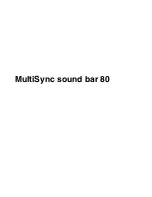
CAUTION!
This product is not a restraint. It will not prevent a resident from getting out of their bed or chair.
This product is designed as a monitor, alerting the staff when the resident has risen from their bed or chair.
This product is to be used in conjunction with a total fall prevention program
PLEASE NOTE: IF YOU DECIDE TO SILENCE THE
ALARM IN THE RESIDENT’S ROOM WHEN USING THE
NURSE CALL SYSTEM, YOU MUST SLIDE THE 1- IN
ROOM SOUND SWITCH UP TO THE “OFF” POSITION.
IF YOU WANT THE ALARM TO SOUND IN THE
RESIDENT’S ROOM THE NEXT TIME USED YOU MUST
MOVE THE IN ROOM SOUND SWITCH DOWN TO THE
“ON” POSITION.
6. To use nurse call interface slide nurse call wire down
into open slot at the end of alarm and plug metal jack
into opening marked “Nurse Call.” Tuck “Pull” tabs into
settings compartment. See illustration A.
7. Slide connecting wire of pad through open slot at end
of alarm on top of the nurse call wire and plug metal pin
into opening marked “Pad Jack.” Tuck “Pull” tabs into
setting compartment. Slide both the nurse call and pad
connecting wires through the open slot at end of alarm.
Note: Whenever you want to remove either the nurse
call and/or the pad wires pull up on the tabs marked
“Pull” and remove the connecting wires from the end
of the alarm.
CAUTION! ALWAYS remove sensor
pad pin from alarm by pulling straight up on the
white “PULL” tab. DO NOT attempt to remove pin
any other way or you may damage pin and void
warranty.
8. Slide alarm’s patient-proof cover back into place and
tighten the locking security screw.
9. Place alarm into holder included. Press alarm’s back
firmly against holder to secure Velcro pieces. When it is
necessary to remove the alarm from holder simply pull up
on the alarm.
10. Affix the alarm and holder securely to the side of the bed
or chair out of sight and reach of the resident. Simply
wrap the Velcro strap with the rubberized not-slip backing
attached to the back of the holder tightly around railing or
frame of bed or wheelchair.
CAUTION: Do not affix alarm
to a PVC rail. The strap may permanently stain the rail.
Holder placement should be easily accessible to staff.
Secure excess cord to avoid damaging cord.
11. If using the nurse call interface connect the standard
¼" nurse call wall jack into wall outlet for your nurse call
system in the resident’s room. Check to make certain your
nurse call system is functioning properly.
12. Press down on the # 2 button on the front of the alarm
to test alarm. The alarm will sound continuously until you
enter the 2-3-1 resident proof safety code in sequence
using the numbered buttons on the front of the alarm.
The alarm sound will shut off and the alarm will
automatically reset.
13. Place resident so that resident’s buttocks or shoulder are
in the center of the bed or chair pad. When resident is
placed on the pad the alarm will automatically be set to
sound if the resident attempts to exit the bed or chair.
14. The red “Low Battery Indicator” light will come on when it
is time to change the batteries.
15. NEVER ASSUME! TEST EACH TIME THIS SYSTEM
IS USED.
WARRANTY: Personal Safety Corporation warrants this
product to be free from factory defects in materials and
workmanship for a period of one year from the date of
purchase. Warranty is void if this product is misused, abused
or damaged. No warranty or responsibility of use expressed
or implied.
LOW BATTERY INDICATOR
Test / Reset
VOICE ALARM
Secure
®
Hip Protectors - SHP
(In five sizes)
Secure
®
Reversible Safety
Floor Mat - MAT-1 & MAT-2
Secure
®
Voice Alarm
SVA-1
Secure
®
Universal Alarm
SUA-1
Revised: 07/26/17
Please see our complete line of Secure
®
fall/wandering prevention & patient safety products
at www.SecureSafetySolutions.com
Highest Quality...Lowest Prices...Guaranteed!
Personal Safety Corporation • Hiawatha, Iowa 52233 • 800.373.2873




















